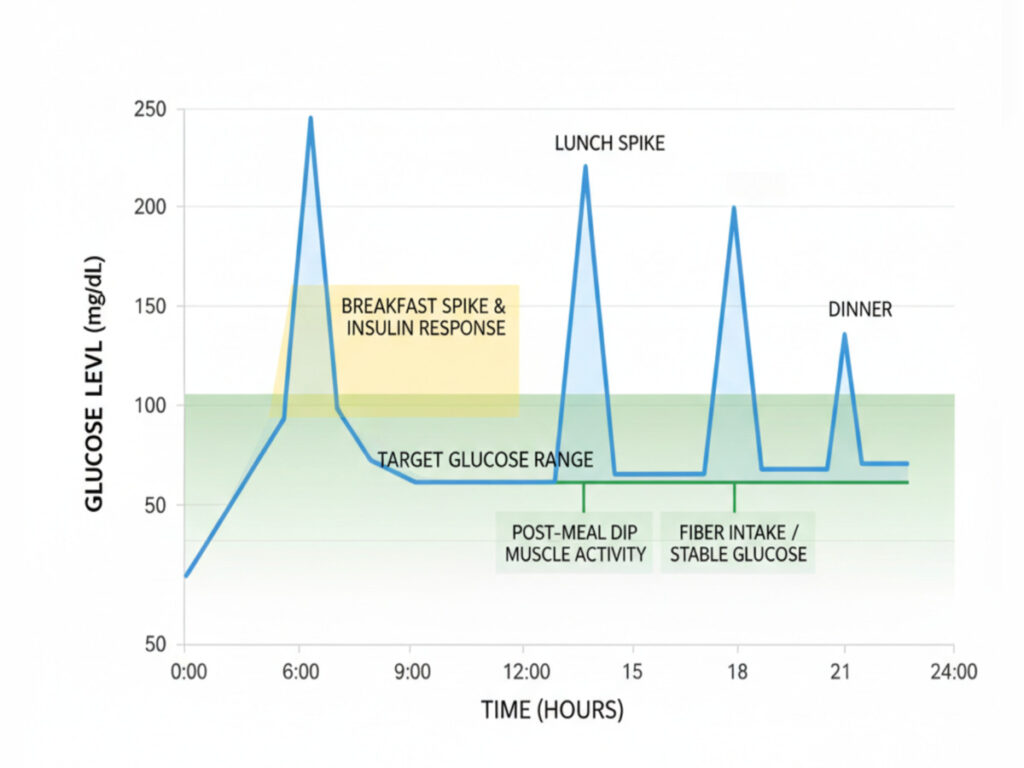Introduction: Understanding Glucose Intelligence
Glucose Intelligence is the practice of tracking and understanding your blood sugar fluctuations in real-time to optimize metabolism, energy, and long-term health.
Unlike traditional approaches that monitor glucose only for diabetes, glucose intelligence empowers healthy adults to tailor nutrition, workouts, and lifestyle habits for maximal performance and metabolic resilience.

Why Glucose Monitoring Matters Beyond Diabetes
Even in non-diabetic adults, blood sugar spikes and dips influence:
- Energy levels throughout the day
- Hunger, cravings, and satiety
- Fat storage and weight management
- Sleep quality and hormone balance
A 2023 study in Cell Metabolism found that individual glucose responses to the same meal varied up to 6x, emphasizing the need for personalized monitoring rather than generic dietary advice.
The Science of Blood Sugar and Metabolism
Blood glucose comes from carbohydrate digestion, converted into energy for cells.
Key processes include:
- Insulin response: Moves glucose into cells
- Glycemic variability: Fluctuations can cause inflammation, fatigue, and fat gain
- Glucose disposal: Enhanced by muscle activity and fiber intake
Continuous glucose monitoring (CGM) devices now allow real-time data tracking, empowering individuals to make decisions based on actual physiology rather than averages.
Statistic: Adults using CGMs reported 15–20% improved post-meal glucose control and better adherence to dietary changes (Harvard Health, 2024).

Key Benefits of Smart Glucose Tracking
- Personalized Nutrition: Identify which foods spike your glucose.
- Optimized Workouts: Schedule exercise for maximal glucose disposal.
- Weight Management: Reduce unnecessary fat storage by avoiding high spikes.
- Improved Energy & Focus: Steady glucose levels support mental clarity.
- Metabolic Resilience: Lower long-term risk of diabetes, heart disease, and inflammation.
How to Implement Glucose Intelligence in Daily Life
- Step 1: Use a CGM or glucometer to track blood sugar for 1–2 weeks.
- Step 2: Log meals, timing, and lifestyle factors alongside glucose readings.
- Step 3: Identify patterns — which foods or habits spike or stabilize glucose.
- Step 4: Adjust nutrition, meal timing, and exercise to minimize harmful spikes.
- Step 5: Reassess periodically for ongoing metabolic insights.
Foods, Timing & Lifestyle Factors That Impact Glucose
- High-glycemic foods: White bread, sugary drinks → spikes
- Fiber-rich foods: Vegetables, legumes, whole grains → stabilize
- Protein and healthy fats: Slow absorption, reduce peaks
- Meal timing: Avoid late-night high-carb meals
- Stress & sleep: Cortisol spikes can elevate glucose even at rest
Exercise and Glucose Response: Optimizing Workouts
- Resistance training: Improves insulin sensitivity and glucose uptake
- High-intensity interval training (HIIT): Rapid glucose disposal post-workout
- Walking after meals: 10–15 minutes can significantly blunt glucose spikes

Practical Checklist for Smart Glucose Tracking
✅ Track glucose for 1–2 weeks with CGM or glucometer
✅ Log meals, sleep, stress, and exercise
✅ Identify high-spike foods and reduce frequency
✅ Pair carbs with protein and fiber
✅ Exercise after meals when possible
✅ Sleep 7–8 hours nightly
✅ Stay hydrated to aid glucose metabolism
Table: Sample Glucose Tracking Routine
| Time | Activity | Food / Meal | Target Glucose Response | Notes |
|---|---|---|---|---|
| 7:00 AM | Wake | Protein + Fiber Breakfast | <120 mg/dL | Oats + eggs + berries |
| 10:00 AM | Mid-morning | Snack | <130 mg/dL | Almonds + Greek yogurt |
| 12:30 PM | Lunch | Balanced Meal | <140 mg/dL | Chicken, quinoa, broccoli |
| 3:00 PM | Post-lunch walk | — | Stabilized | 15-min walk |
| 6:30 PM | Dinner | Protein + Veg | <130 mg/dL | Salmon + roasted veggies |
| 8:00 PM | Light activity | — | Stable | Gentle stretch/walk |
Expert Insights on Glucose Intelligence
“Understanding your personal glucose patterns is the ultimate tool for metabolic optimization. Everyone responds differently — personalization is key.”
— Dr. Laura Michaels, RD, Metabolic Health Specialist
“CGMs are no longer just for diabetics. They empower people to make decisions that improve energy, weight, and long-term health.”
— Dr. Michael Stern, MD, Nutrition Researcher
Common Myths & FAQ
Q1: CGMs are only for diabetics.
A: Modern CGMs are used by healthy adults for performance, energy, and weight management.
Q2: I can just follow generic diets instead.
A: Generic advice often misses individual glucose responses. Personalized tracking is more effective.
Q3: Will glucose tracking make me obsessed with numbers?
A: When used properly, it increases awareness without creating anxiety, empowering better decisions.
Q4: How long should I track?
A: Initial 1–2 week period for pattern recognition; reassess periodically for optimization.
Authoritative Resources
- Harvard Health – Continuous Glucose Monitors for Non-Diabetics
- American Diabetes Association – Understanding Blood Sugar
- Mayo Clinic – Blood Glucose Testing
Related Fitoast Articles
- Fibermaxxing: Maximizing Dietary Fiber for Gut Health, Satiety, and Long-Term Wellness
- The Longevity Lift: Strength Training Strategies for Aging Better in 2025
Conclusion & Call-to-Action
Glucose Intelligence is a game-changer for metabolic health.
By tracking your personal blood sugar patterns, you can optimize meals, workouts, and lifestyle to reduce spikes, improve energy, manage weight, and build long-term metabolic resilience.
Next Steps:
Start tracking, analyze patterns, adjust nutrition and activity, and embrace the power of personalized glucose insights. Your energy, fitness, and healthspan will thank you.

